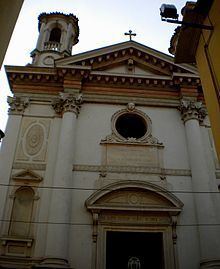Affiliation Roman Catholic Groundbreaking 1737 Opened 1749 | Completed 1749 Architectural style Baroque architecture Year consecrated 1181 | |
 | ||
Location Padova Padova - Stemma.png Rite Roman Catholic, Western rite Similar Diocesan museum of Padua - It, Santuario di San Leopoldo, Madonna Addolorata al Torresi, Santa Sofia Church, Saint Nicolò | ||
Santa Croce is a Roman Catholic church located on Corso Vittorio Emanuele 178 in Padua, Region of Veneto, Italy.
Contents
The church arose adjacent to the oratory of Sant Croce or Sala del Redentore. A chapel at the site, adjacent to a leprosarium, was dedicated to the Holy Cross as is documented in 1181. The church became a parish in 1308. In 1606, the parish came under the rule of the Somaschi Fathers, who established a school at this site. The commission to build the present Rococo style church was given to a lay brother of the order, Francesco Vecelli (1695–1759). Construction began in 1737 and was completed in 1749. Under Napoleonic rule, the Somaschi were expelled and the church came under control of secular clergy. The belltower was built in 1907.
Exterior
The façade was designed to be a monument at the end of the Borgo Santa Croce, running from the Prato della Valle to the outer wall. It has a pediment supported by pilasters and half-columns of Corinthian order. Two circular turrets lighten the architecture. The main door has a curved tympanum under the inscription that commemorates the consecration of the church. The late-Baroque and early Neoclassical design was by the architect Girolamo Frigimelica of Padua.
Interior
The bright hall features a stylish decorative parade on which is placed a series of openings in fenestrated fake balcony, probably as choirs. The presbytery with semicircular apse is decorated with impressive semi columns. The ceiling of the church is decorated with coffers, stucco and gilding. The frescoes have been attributed to Gualtieri, Girolamo dal Santo, Domenico Campagnola, and Stefano Dall' Arzere.
The ceiling has a central fresco by Nicolò Baldassini depicting the Exaltation of the Cross. Baldassini also frescoed the cupola and presbytery. The main altar has two angels sculpted by Antonio Bonazza (1698–1763). The apse has a wooden choir. The church has four altarpieces by Giovanni Battista Mariotti (1690–1748). Another fresco depicting the Holy Heart of Jesus was painted by Giovanni Dandolo.
Through a door on the right, one can enter the Cappella della Madonna della Neve (Chapel of the Madonna of the Snows) and the Sala del Redentore or Oratory of the Confraternity of the Redeemer. The oratory dates to the 15th-century and was the home of the former Confraternity of the Corpo di Cristo di Santa Croce established at the end of the 15th century. The confraternity was involved in tending to the poor and burying the impoverished. The frescoes of the oratory have been restored.
Altar
Cleric Somascan entrusted the decoration of the ceiling (Exaltation of the Cross) and the egg-shaped dome of the presbytery to the Venetian Nicolo Baldassini. A cycle of paintings (side altars and apse) was commissioned Giambattista Mariotti. The location of the paintings was altered with the arrival of the early 800 Salus Populi Patavini, venerated seventeenth-century wooden statue of Our Lady of Health, coming from the oratory and linked to the plague that struck the city in the seventeenth century.
On the first altar to the right from the entrance is a painting of the Mariotti with St. John of Nepomuk, St. Francis of Paola and Antonio. The high altar, decorated with a variety of multi-colored marble, is lightened by two praying angels by Antonio Bonazza. Above, a rich roccoco canopy. The wooden choir is below St. Helena loves the Holy Cross by Mariotti. On the first altar on the left from the entrance, there is the painting of St. Jerome by Emiliani.
Bell Tower
The bell tower on the side of the twentieth-century church is built on the area of the cemetery.
